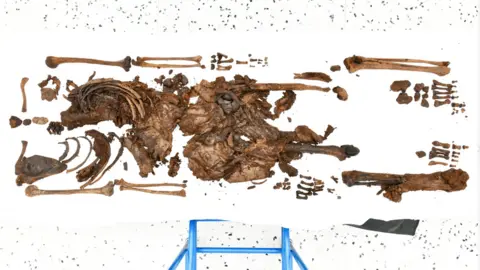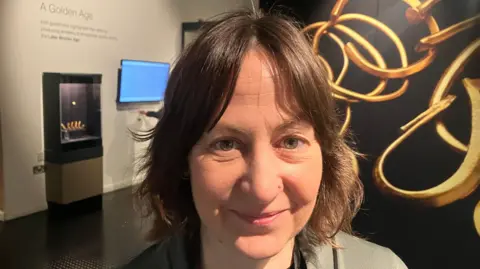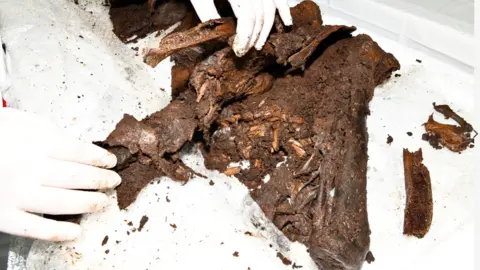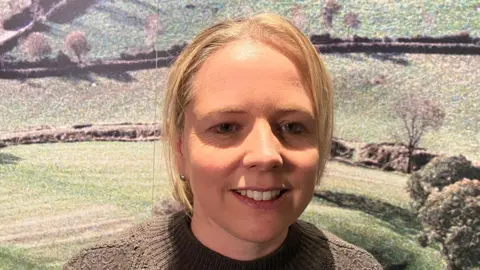Iron Age remains found in bog may have been sacrificial
 PSNI
PSNIAncient human remains discovered in peatland in County Londonderry in 2023 are now thought to be those of a young woman who died more than two millennia ago.
She is believed to have been killed as part of an Iron Age ritual or sacrifice.
When the 2,000 year old remains were initially discovered close to Bellaghy it was thought they could be those of a teenage boy.
But experts from the Ulster Museum and a number of universities, including Queen's University Belfast (QUB), have carried out further research on the body.
The remains, which were discovered in October 2023, are now thought to be those of a young woman aged between 17 and 22 years old.
She was about 5ft 6in tall (1.7m).
Dating to approximately 343 to 1 BC they are more than 2000 years old, and from the prehistoric period known as the Iron Age.
The remains will now be called the "Ballymacombs More Woman" after the townland where they were found.
Curator of archaeology at National Museums NI (NMNI), Niamh Baker, told BBC News NI the discovery of the remains was "very significant".
"There was evidence of cut marks on the neck vertebrae," she said.
Ms Baker said it showed "that the individual had been intentionally decapitated at the bog".
During the discovery in 2023, no skull was recovered with the remains.
"It was likely that that was taken away at the time, during the Iron Age," Ms Baker added.
"Perhaps it is part of a pattern of ritual killings and sacrifice...there is a pattern of that across North-West Europe and Ireland."

QUB professor of archaeology Eileen Murphy carried out an assessment of the body.
She said the young woman's fate was not untypical of finds from the era.
"As is the case for so many Iron Age bog bodies, the young woman suffered a highly violent death which involved the flow of blood from her throat followed by decapitation," she said.
"The head was taken away, but the body was left where it fell only to be discovered by machine workers some 2,000 years later."
 PSNI
PSNIMs Baker said more research would now be carried out on the remains, to provide more clues about how people lived during the Iron Age.
"We'll hopefully find out information potentially about her diet, potentially about her movement," she said.
"That will be able to determine information about who she was, perhaps what population she was part of.
"There's very little evidence that tells us about everyday life during the Iron Age.
"What has survived are high-quality, prestige artefacts and objects that tell us that during this time there was a social elite.
Some woven fabric, made of plant material, was found with the body and may go on display in the future.
'Treating remains respectfully'
Navan Fort in County Armagh is the best known Iron Age settlement in Northern Ireland.
Photos of the remains were released by the PSNI shortly after they were discovered, but they are unlikely to go on public display in the Ulster Museum.
That is because, according to NMNI's head of curatorial, Hannah Crowdy, museums have to "think very carefully" about the human remains they hold and how to treat them respectfully.
"The nature of death of this individual was that she was decapitated and obviously that means the remains are in a certain condition that might be distressing for people to see," she said.
"There has to be a really strong argument for displaying them, we would never want to display them for sensational purposes."
"We think we can do a really compelling, really interesting display to help people understand the processes and to tell this young woman's story without showing her remains to the public."
That could include artist's impressions of how the young woman appeared when she was alive.

Hannah Crowdy said conversations were also taking place about Takabuti, the Egyptian mummy, which has been one of the Ulster Museum's best known exhibits for generations.
"There's lots of complex issues to explore," she said.
"With Takabuti there's a very active conversation about if and how she's displayed and about her future."
The museum has brought together a range of experts from across the UK and Egypt to discuss Takabuti's future.
"They're helping inform our thinking on this, and we're also talking to our audiences," she said.
Ms Crowdy added there are strong arguments for and against displaying Takabuti.
"We're just navigating those at the moment and trying to do as much consultation as we can."
